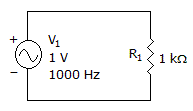Discussion
Home ‣ Electronics ‣ Alternating Current vs Direct Current See What Others Are Saying!
- Question
The current is flowing in what direction?

Options- A. clockwise
- B. counterclockwise
- C. in both directions at the same time
- D. 50% of the time clockwise and 50% of the time counterclockwise
- Correct Answer
- 50% of the time clockwise and 50% of the time counterclockwise
- 1. JFET terminal "legs" are connections to the drain, the gate, and the:
Options- A. channel
- B. source
- C. substrate
- D. cathode Discuss
- 2. Capacitive reactance is inversely proportional with frequency.
Options- A. True
- B. False Discuss
- 3. What is the average value of a 12 V peak wave?
Options- A. 3.82 V
- B. 4.24 V
- C. 7.64 V
- D. 9.42 V Discuss
- 4. The DIAC is a:
Options- A. transistor
- B. unidirectional device
- C. three-layer device
- D. bidirectional device Discuss
- 5. Phase angle is the difference in phase between the applied voltage (VS) and the circuit current (IT).
Options- A. True
- B. False Discuss
- 6. Which is considered to be the common reference for a parallel circuit?
Options- A. Voltage
- B. Current
- C. Power
- D. Resistance Discuss
- 7. 0.00015 V can be expressed in powers of ten as 1.5 × 10?4 V.
Options- A. True
- B. False Discuss
- 8. A 10 µF capacitor will have more capacitive reactance than a 20 µF capacitor in a 60 Hz circuit.
Options- A. True
- B. False Discuss
- 9. A JFET can be either a current-controlled device or a voltage-controlled device.
Options- A. True
- B. False Discuss
- 10. The effectiveness of a filter in rejecting signals beyond cutoff frequency is a function of the filter roll-off rating.
Options- A. True
- B. False Discuss
More questions
Correct Answer: source
Correct Answer: True
Correct Answer: 7.64 V
Correct Answer: bidirectional device
Correct Answer: True
Correct Answer: Voltage
Correct Answer: True
Correct Answer: True
Correct Answer: True
Correct Answer: True
Comments
There are no comments.More in Electronics:
Programming
Copyright ©CuriousTab. All rights reserved.
